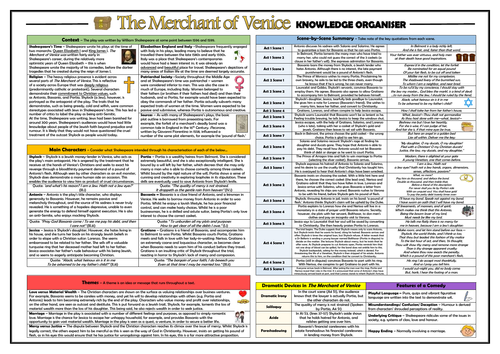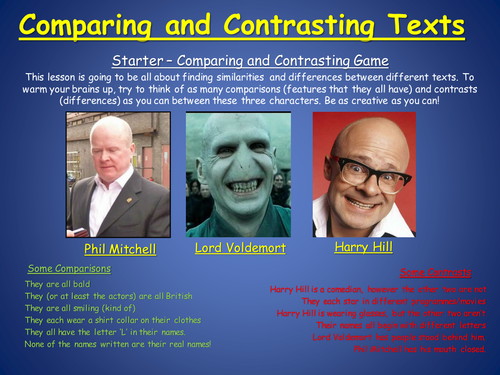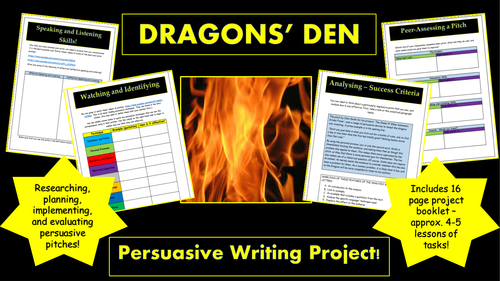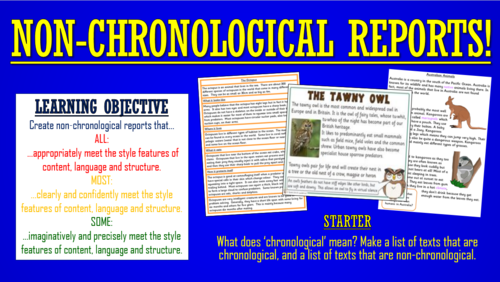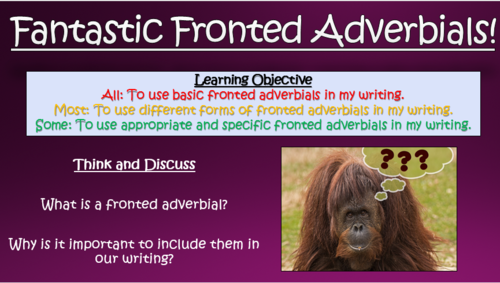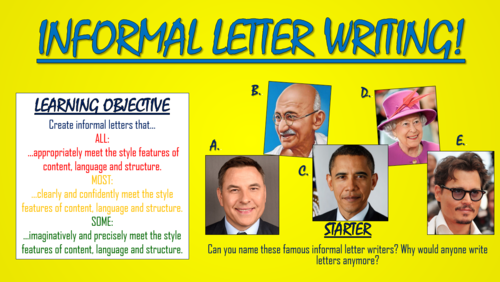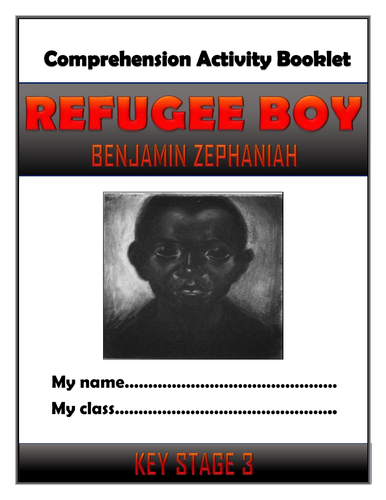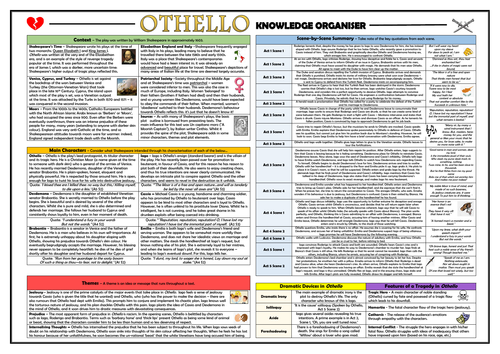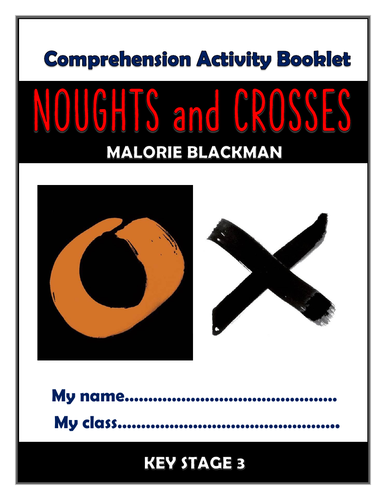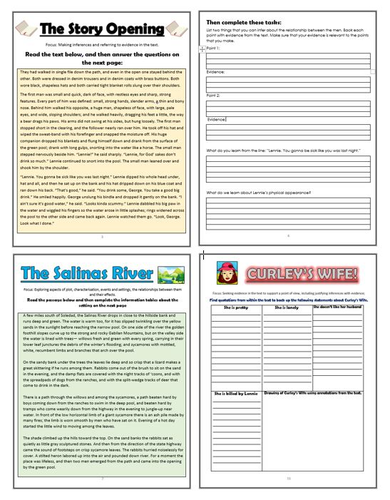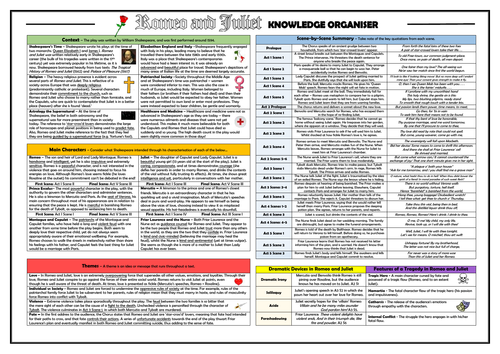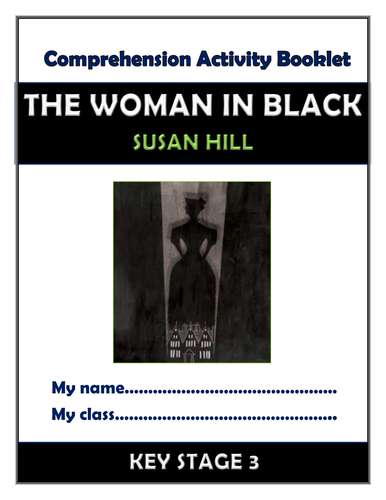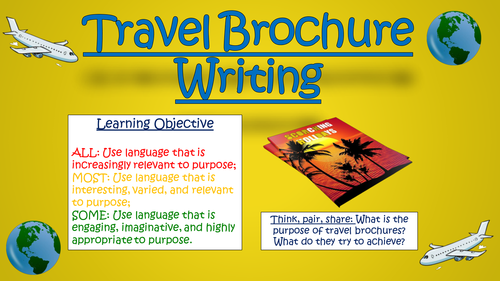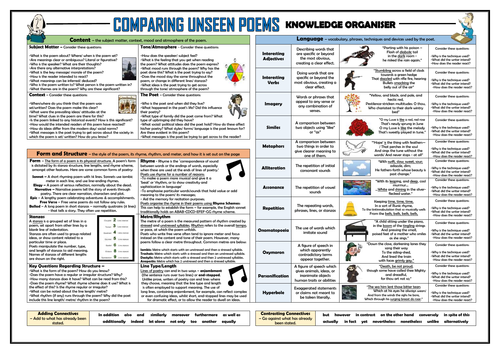
3k+Uploads
1880k+Views
2219k+Downloads
English

The Merchant of Venice Knowledge Organiser/ Revision Mat!
This detailed and visually-appealing resource offers a complete reference point for students learning or revising William Shakespeare’s ‘The Merchant of Venice.’ It contains comprehensive sections on:
Context;
Scene by Scene Summary (with quotes);
Main Characters;
Themes;
Dramatic Devices;
Features of Comedy.
Key words and ideas are underlined for easy reference. The resource is designed to be printed onto A3, and is provided as both a PDF and a Word version (so that you can edit if you want to). All images used are licensed for commercial use and are cited on a separate document (included).

Of Mice and Men Knowledge Organiser/ Revision Mat!
This detailed and visually-appealing resource offers a complete reference point for students learning or revising John Steinbeck's 'Of Mice and Men.' It contains comprehensive sections on:
- Context;
- Chapter by Chapter Summary (with quotes);
- Main Characters;
- Themes;
- Literary Features;
- The Origins of the Book Title.
Key words and ideas are underlined for easy reference. The resource is designed to be printed onto A3, and is provided as both a PDF and a Word version (so that you can edit if you want to). All images used are licensed for commercial use and are cited on a separate document (included).
Bundle Sale

Animal Farm Huge Bundle!
THIS BUNDLE CONTAINS ALL OF THE ANIMAL FARM LESSONS, IN ADDITION TO THE 30-PAGE ANIMAL FARM COMPREHENSION BOOKLET, THE KNOWLEDGE ORGANISER AND THE POINTLESS GAME!
This engaging, varied, and informative scheme of learning is designed to help students gain a valuable understanding of George Orwell’s allegorical novella ‘Animal Farm.’ The lessons enable students to gain a comprehensive understanding of the key features of plot, character, context, and language, in addition to considering the key messages being offered by Orwell.
All of the resources that you need are included in the bundle: informative and engaging whole lesson PowerPoints, worksheets, activities, and lesson plans.
The bundle is made up of a wide-range of interesting and exciting lessons, including:
- The Russian Revolution;
- Old Major’s Dream;
- The Rise of the Pigs;
- Dictatorship;
- Squealer;
- The Ending (Orwell’s Message)
Stimulating, visual, and easily adaptable, these lessons provide suggested learning objectives and outcomes for students of a wide-range of abilities - The vast majority of tasks are differentiated to allow for different abilities and needs in your classroom. Each lesson loosely follows this logical learning journey to ensure that students learn in bite-size steps:
- Engaging
- Defining/ Understanding
- Identifying/Remembering
- Analysing/ Creating
- Peer or self evaluating.
All of the lessons are interactive, employ a variety of different teaching and learning methods and styles, and are visually-engaging.

Writing Emails!
This stimulating and informative lesson develops students’ skill in creating emails that precisely meet the needs of their audience and purpose. In particular, they gain an in-depth understanding of how emails should be structured, what information should be included within them, and what style they should be written in, in order to meet their audience and purpose.
Students follow a clear and logical learning journey, in which they:
-Understand when and where emails are an appropriate form of communication;
-Establish the structural features of emails;
-Work collaboratively to identify and analyse the content and language features in further model examples of emails;
-Understand how email features are influenced by the purpose and audience of the email;
-Create a success criteria for writing emails (although a ready-made success criteria is included);
-Write their own emails, using a helpsheet (if needed) and the techniques that they have learnt;
-Peer/self-assess their writing attempts.
There are enough resources here really for two lessons, including:
-Visually engaging whole-lesson PowerPoint;
-Email examples x 3
-Email purpose and audience sorting cards;
-Writing emails helpsheet;
-Structure of emails worksheet;
-Step-by-step lesson plan.
All images are licensed for commercial use, and are cited on the final page of the slide.

New GCSE English Language - Comparing and Contrasting
This informative and engaging double lesson aims to improve students’ ability to compare and contrast two different texts based on a similar subject. They will focus particularly on the purpose, audience, language, and structure of texts, and will learn to use comparing and contrasting connectives to highlight any similarities and differences. This has always been a crucial skill in English, but has an increased importance in the new GCSE for English Language, as there is a greater requirement for students to be able to make links and comparisons between texts.
The lesson follows a clear and logical learning journey, with students learning to:
- Understand the key terms 'compare' and 'contrast', and the importance of these skills in English;
- Categorise the different features that they can compare, under the headings 'Purpose', 'Audience', 'Language' and 'Structure;'
- Read (and identify the key features within) two morally and ethically intriguing texts, offering diverse views of young people in the media;
-Compare the two texts, using a clear and concise template, and newly-acquired knowledge of different types of connectives;
- Peer-assess each other's comparative essay attempts.
Included in this resource pack are:
- Whole double lesson, colourful and engaging PowerPoint presentation (Including assessment for learning referral slides)
- Cards for card-sorting activity;
- Two interesting and thought-provoking non-fiction media extracts (one a newspaper extract from The Evening Standard, and another a persuasive leaflet, both focused on the issue of how young people are perceived.)
- Template for main comparative analysis task;
- Full teacher guidance plan.
All images are licensed for commercial use and are cited on the final slide of the PowerPoint presentation

Dragons' Den Persuasive Project! (Building Speaking & Listening and Persuasive Writing Skills!)
This resource is perfect for enabling students to build both their persuasive writing and their speaking and listening skills. Based upon the popular BBC series 'Dragons' Den', students have the opportunity to research, design, pitch, and evaluate arguments for their own inventions, whilst simultaneously analysing persuasive pitches, revising persuasive techniques, structuring arguments and articulating convincingly.
Included is a 16 page booklet (I would say at least 4-5 hour lessons of tasks) that lead students to:
- Introduce themselves and their interests;
- Watch persuasive pitches (links included) and identify persuasive devices;
- Analyse why persuasive devices are effective;
- Structure an analysis appropriately;
- Brainstorm ideas for an invention using imagination and helpful aiding questions;
- Formulate an argument by considering key questions and counter arguments;
- Write and present a persuasive pitch;
- Peer-evaluate and self-evaluate persuasive pitches.
I have also provided some examples of news stories featuring the worst and best pitches from the den, in order to provoke discussion about what makes a strong pitch.
All images are licensed for commercial use and are cited throughout.

Non-Chronological Reports!
This stimulating and informative lesson develops students’ skill in creating non-chronological reports that precisely meet the content, language and structural features of the form. In particular, they gain an in-depth understanding of how non-chronological reports are ordinarily set out on the page, what information should be included within them, and what style they should be written in, in order to meet form and purpose. These resources contain 3 example non-chronological reports, differentiated by the accessibility of their language.
Students follow a clear and logical learning journey, in which they:
-Define what non-chronological letters are and clarify their purpose;
Establish the structural features of non-chronological letters;
-Work collaboratively to identify and analyse the content and language features in further model examples of non-chronological reports;
-Create a success criteria for effective non-chronological reports;
-Write their own non-chronological reports, using a planning sheet (if needed) and the techniques that they have learnt;
-Peer/self-assess their writing attempts.
There are enough resources here really for two lessons, including:
-Visually engaging whole-lesson PowerPoint;
-Non-chronological reports x 3 (based on tennis, great white sharks, and Dubai)
-Non-chronological reports structure worksheet;
-Non chronological reports planning sheet;
-Step-by-step lesson plan.
All images are licensed for commercial use, and are cited on the final page of the slide.

Fantastic Fronted Adverbials!
This engaging and detailed resource pack has been designed to make the learning of fronted adverbials (particularly prominent in the new curriculum) easily accessible, engaging and interesting for all children. Throughout the lesson, students learn to improve their skill at using appropriate, concise, and precise fronted adverbials within their own writing compositions. In addition to the comprehensive lesson, resources, and plan, it also includes a fronted adverbials writing mat to assist students in building their extended writing skills.
The lesson follows a clear, logical, bite-size learning journey, which guides students towards differentiated learning objectives. Over the course of this journey, they become able to:
- Define what fronted adverbials are;
- Identify fronted adverbials in sentences;
- Analyse and evaluate what it is that makes some fronted adverbials more effective than others;
- Write an extended piece with the employment of fronted adverbials;
-Peer/self-assess learning attempts.
This resource pack includes:
- A visually engaging whole-lesson PowerPoint presentation;
- A clear and interesting worksheet for the development task;
- An interesting short story for students to analyse;
- A hyperlink to an engaging and heart-warming video through a hyperlink in the presentation;
- A detailed lesson plan, complete with what the teacher and students should aim to achieve at each stage of the lesson.
All images are licensed for commercial use, and are cited on the final slide of the PowerPoint/ the bottom of worksheets.

Informal Letter Writing!
This stimulating and informative lesson develops students’ skill in creating informal letters that precisely meet the content, language and structural features of the form. In particular, they gain an in-depth understanding of how informal letters should be set out on the page, what information should be included within them, and what style they should be written in, in order to meet form, audience and purpose.
Students follow a clear and logical learning journey, in which they:
-Understand why letter writing is still important in the present day;
-Unjumble a model example of an informal letter in order to establish its structure;
-Work collaboratively to identify and analyse the content and language features in further model examples of informal letters;
-Create a success criteria for effective informal letters (although a ready-made success criteria is included);
-Write their own informal letters, using a structure strip and helpsheet (if needed) and the techniques that they have learnt;
-Peer/self-assess their writing attempts.
There are enough resources here really for two lessons, including:
-Visually engaging whole-lesson PowerPoint;
-Informal letters x 3 (based on The Simpsons, Batman, and Harry Potter characters)
-Informal letters structure strip;
-Informal letters helpsheet;
-Step-by-step lesson plan.
All images are licensed for commercial use, and are cited on the final page of the slide.

Refugee Boy KS3 Comprehension Activity Booklet!
This resource booklet contains a wide range of age-appropriate, engaging, and meaningful comprehension activities for use throughout the reading of Benjamin Zephaniah’s ‘Refugee Boy.’ Teachers have found them particularly useful in comprehension or guided reading sessions. They are perfect for aiding the progress of children towards meeting the KS3 expectations within the new National Curriculum framework. Children have found these resources extremely engaging, and for teachers there is explicit information within each task regarding which comprehension strands the task is designed to demonstrate. They also relate to key extracts, characters, and themes from the story, ensuring that children gain a deep understanding of the text.
Activities within the booklet include:
‘Context: Eritrean-Ethiopian War’ - to enable students to demonstrate that they can: ‘Know the purpose, audience and context of the writing and drawing on this knowledge to support comprehension.’
‘Zephaniah’s Description’ - to enable students to demonstrate that they can: ‘Know how language, including figurative language, vocabulary choice, grammar, text structure and organisational features, present meaning.’
‘Mr and Mrs Fitzgerald Character Profile’ - to enable students to demonstrate that they can: ‘Study setting, plot, and characterisation, and the effects of these.’
‘Vocabulary Inspector’ - to enable students to demonstrate that they can: ‘Learn new vocabulary, relating it explicitly to known vocabulary and understanding it with the help of context and dictionaries.’
Plus many, many more activities (the booklet is 23 pages in length!) I’ve also added it as a PDF in case the formatting differs on your computer.
All images are licensed for commercial use, and are cited on a separate document (included).

Othello Knowledge Organiser/ Revision Mat!
This detailed and visually-appealing resource offers a complete reference point for students learning or revising William Shakespeare’s ‘Othello.’ It contains comprehensive sections on:
Context;
Scene by Scene Summary (with quotes);
Main Characters;
Themes;
Dramatic Devices;
Features of Tragedy.
Key words and ideas are underlined for easy reference. The resource is designed to be printed onto A3, and is provided as both a PDF and a Word version (so that you can edit if you want to). All images used are licensed for commercial use and are cited on a separate document (included).

Noughts and Crosses - KS3 Comprehension Activities Booklet!
This resource booklet contains a wide range of age-appropriate, engaging, and meaningful comprehension activities for use throughout the reading of Malorie Blackman’s ‘Noughts and Crosses.’ Teachers have found them particularly useful in comprehension or guided reading sessions. They are perfect for aiding the progress of children towards meeting the KS3 expectations within the National Curriculum framework. Children have found these resources extremely engaging, and for teachers there is explicit information within each task regarding which comprehension strands the task is designed to demonstrate. They also relate to key extracts, characters, and themes from the story, ensuring that children gain a deep understanding of the text.
Activities within the booklet include:
‘Blackman’s Description’ - to enable students to demonstrate that they can: ‘Know how language, including figurative language, vocabulary choice, grammar, text structure and organisational features, present meaning.’
‘Callum McGregor Character Profile’ - to enable students to demonstrate that they can: ‘Study setting, plot, and characterisation, and the effects of these.’
‘Context: Jim Crow Laws’ - to enable students to demonstrate that they can: ‘Know the purpose, audience and context of the writing and drawing on this knowledge to support comprehension.’
‘Vocabulary Inspector’ - to enable students to demonstrate that they can: ‘Learn new vocabulary, relating it explicitly to known vocabulary and understanding it with the help of context and dictionaries.’
Plus many, many more activities (the booklet is 23 pages in length!) I’ve also added it as a PDF in case the formatting differs on your computer.
All images are licensed for commercial use.

Of Mice and Men Comprehension Activity Booklet!
This resource booklet contains a wide range of age-appropriate, engaging, and meaningful comprehension activities for use throughout the reading of John Steinbeck's 'Of Mice and Men.' Teachers have found them particularly useful in exam revision, comprehension tasks, or guided reading sessions. They are perfect for aiding the progress of students towards meeting the KS4 expectations within the new National Curriculum framework - this makes the tasks suitable for all examining bodies. Students have found these resources extremely engaging, and for teachers there is explicit information within each task regarding which comprehension strands the task is designed to demonstrate. They also relate to key extracts, characters, and themes from the story, ensuring that students gain a deep understanding of the text.
Activities within the booklet include:
- 'Context: The Great Depression' - to aid students with 'Drawing on knowledge of the purpose, audience and context of the writing, including its social, historical and cultural context and the literary tradition to which it belongs, to inform evaluation;'
- 'Steinbeck's Description' - to aid students with 'Analysing a writer’s choice of vocabulary, form, grammatical and structural features, and evaluating their effectiveness and impact;'
- 'Curley's Wife' - to aid students with 'Seeking evidence in the text to support a point of view, including justifying inferences with evidence;'
- 'Editing the Text' - to aid students with 'Making an informed personal response, recognising that other responses to a text are possible and evaluating these.'
Plus many, many more activities (the booklet is around 30 pages in length!) I've also added it as a PDF in case the formatting differs on your computer.
All images are licensed for commercial use, and are cited on a separate document (included).

Romeo and Juliet Knowledge Organiser/ Revision Mat!
This detailed and visually-appealing resource offers a complete reference point for students learning or revising William Shakespeare's 'Romeo and Juliet.' It contains comprehensive sections on:
- Context;
- Scene by Scene Summary (with quotes);
- Main Characters;
- Themes;
- Dramatic Devices;
- Features of Tragedy.
Key words and ideas are underlined for easy reference. The resource is designed to be printed onto A3, and is provided as both a PDF and a Word version (so that you can edit if you want to). All images used are licensed for commercial use and are cited on a separate document (included).
Bundle Sale

To Kill a Mockingbird Huge Bundle!
THIS BUNDLE CONTAINS ALL OF THE ‘TO KILL A MOCKINGBIRD’ LESSONS, IN ADDITION TO THE KNOWLEDGE ORGANISER, THE 30-PAGE COMPREHENSION BOOKLET, AND THE POINTLESS GAME!
This engaging, varied, and informative scheme of learning is designed to help students gain understanding, assessment skills, and key interpretations of Harper Lee’s novel ‘To Kill a Mockingbird.’ Made up of a wide-range of interesting and exciting lessons, students should complete this scheme having gathered vital skills in: interpreting the significant meanings of the novel, understanding the writer’s ideas within the text, analysing key characters, settings, and themes, and understanding Lee’s language devices.
Stimulating, visual, and easily adaptable, these lessons provide suggested learning objectives and outcomes for students of a wide-range of abilities - The vast majority of tasks are differentiated to allow for different abilities and needs in your classroom. Each lesson loosely follows this logical learning journey to ensure that students learn in bite-size steps:
Engaging
Defining/ Understanding
Identifying/Remembering
Analysing/ Creating
Peer or self evaluating.
All of the lessons are interactive, employ a variety of different teaching and learning methods and styles, and are visually-engaging. Resources, worksheets, and lesson plans are all provided.
Bundle Sale

The Merchant of Venice Huge Bundle!
THIS BUNDLE CONTAINS ALL OF THE MERCHANT OF VENICE LESSONS, IN ADDITION TO THE COMPREHENSION ACTIVITY BOOKLET, THE MERCHANT OF VENICE KNOWLEDGE ORGANISER, AND THE POINTLESS GAME!
This engaging, varied, and informative scheme of learning is designed to help students gain understanding, assessment skills, and key interpretations of William Shakespeare’s ‘The Merchant of Venice.’ Made up of a wide-range of interesting and exciting lessons, students should complete this scheme having gathered vital skills in: interpreting the significant meanings of the play, understanding the writer’s ideas within the play, analysing key characters, settings, and themes, and understanding Shakespeare’s language devices.
Stimulating, visual, and easily adaptable, these lessons provide suggested learning objectives and outcomes for students of a wide-range of abilities - The vast majority of tasks are differentiated to allow for different abilities and needs in your classroom. Each lesson loosely follows this logical learning journey to ensure that students learn in bite-size steps:
Engaging
Defining/ Understanding
Identifying/Remembering
Analysing/ Creating
Peer or self evaluating.
All of the lessons are interactive, employ a variety of different teaching and learning methods and styles, and are visually-engaging. Resources, worksheets, and lesson plans are all provided.

The Woman in Black - KS3 Comprehension Activities Booklet!
This resource booklet contains a wide range of age-appropriate, engaging, and meaningful comprehension activities for use throughout the reading of Susan Hill's 'The Woman in Black.' Teachers have found them particularly useful in comprehension or guided reading sessions. They are perfect for aiding the progress of children towards meeting the KS3 expectations within the new National Curriculum framework. Children have found these resources extremely engaging, and for teachers there is explicit information within each task regarding which comprehension strands the task is designed to demonstrate. They also relate to key extracts, characters, and themes from the story, ensuring that children gain a deep understanding of the text.
Activities within the booklet include:
- 'Context: The Rural North' - to enable students to demonstrate that they can: 'Know the purpose, audience and context of the writing and drawing on this knowledge to support comprehension.'
- 'Hill's Description - The Horse and Trap' - to enable students to demonstrate that they can: 'Know how language, including figurative language, vocabulary choice, grammar, text structure and organisational features, present meaning.'
- 'Mr Jerome' and 'The Woman in Black' - to enable students to demonstrate that they can: 'Study setting, plot, and characterisation, and the effects of these.'
- 'Vocabulary Inspector' - to enable students to demonstrate that they can: 'Learn new vocabulary, relating it explicitly to known vocabulary and understanding it with the help of context and dictionaries.'
Plus many, many more activities (the booklet is 21 pages in length!) I've also added it as a PDF in case the formatting differs on your computer.
All images are licensed for commercial use, and are cited on a separate document (included).

Writing Newspaper Articles!
This interesting and engaging enables students to know what newspaper articles are and why people read them, understand the features that make effective newspaper articles, and write their own interesting and appropriate newspaper articles. In particular, students learn to use a range of appropriate features in writing their own newspaper articles, including facts and opinions, jargon, testimonies, and puns. There are easily enough resources here for 2 lessons on this topic.
Over the course of their learning journey, students:
- Define and exemplify what newspapers are;
- Understand why people read newspapers;
- Understand and categorise the different techniques used by newspapers;
- Identify the features of newspapers in model examples;
- Analyse the effect of techniques in newspapers upon the reader;
- Use a wide-range of techniques in writing their own newspaper articles;
- Peer and self assess each other's newspaper article attempts.
The resources include:
-Visually engaging whole-lesson PowerPoint;
-A colourful and helpful 'Writing Newspaper Articles' Help-Sheet;
-Techniques cards for defining the key key features of newspaper articles;
-Analysing newspaper articles worksheet;
-Blank newspaper article template;
-A model example of a newspaper article;
-Helpful and comprehensive step-by-step lesson plan.
All images are licensed for commercial use, and are cited on the final page of the slide.

Travel Brochure Writing!
This engaging and stimulating lesson enables students to create travel brochure texts containing appropriate and imaginative language choices, utilising a range of different language techniques with subtlety in order to craft writing that serves the dual purpose of being descriptive and persuasive. In particular, students learn how descriptive language such as of similes, metaphors, and personification, in addition to persuasive devices such as statistics, rhetorical questions, and personal pronouns, can help to create truly authentic and effective travel brochure pieces.
The lesson follows a clear, logical, bite-size learning journey, which guides students towards differentiated learning objectives. Over the course of this journey, they become able to:
- Define what travel brochures are and understand their purposes;
- Identify the persuasive and descriptive language devices that travel brochure writers employ
- Analyse the effects of the language in a model travel brochure text;
- Utilise a clear and challenging success criteria document in order to construct their own travel brochure pieces;
- Self/Peer assess travel writing attempts.
This resource pack includes:
- A visually engaging whole-lesson PowerPoint presentation;
- An interesting and ambitious travel writing extract (with a highlighted version for teachers):
-A logical and challenging worksheet, encouraging students to analyse key features;
- A detailed lesson plan, complete with what the teacher and students should aim to achieve at each stage of the lesson.
All images are licensed for commercial use, and are cited on the final slide of the PowerPoint.

Comparing Unseen Poetry Knowledge Organiser/ Revision Mat!
This detailed and visually-appealing resource offers a complete reference point for students preparing for the ‘Unseen Poetry’ elements of English Literature examinations. It is ideal for GCSE and A Level students, as it contains detailed and comprehensive sections (including explanations, examples and key questions) on:
Content -Subject Matter, Context, Tone, Atmosphere, The Poet;
Language - Similes, Metaphors, Interesting Adjectives, Interesting Verbs, Imagery, Onomatopoeia, Alliteration, Assonance, Personification, Hyperbole, Oxymoron, Repetition;
Form and Strcuture - Common Forms, Rhyme/ Rhyme Schemes, Metre, Rhythm, Stanzas, Line Type, Line Length.
Plus lists of Adding Connectives and Contrasting Connectives for use when comparing.
Key words and ideas are underlined for easy reference. The resource is designed to be printed onto A3, and is provided as both a PDF and a Word version (so that you can edit if you want to). All images used are licensed for commercial use and are cited on a separate document (included).

